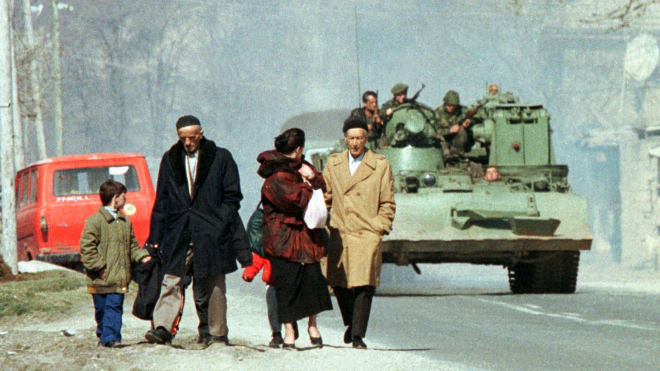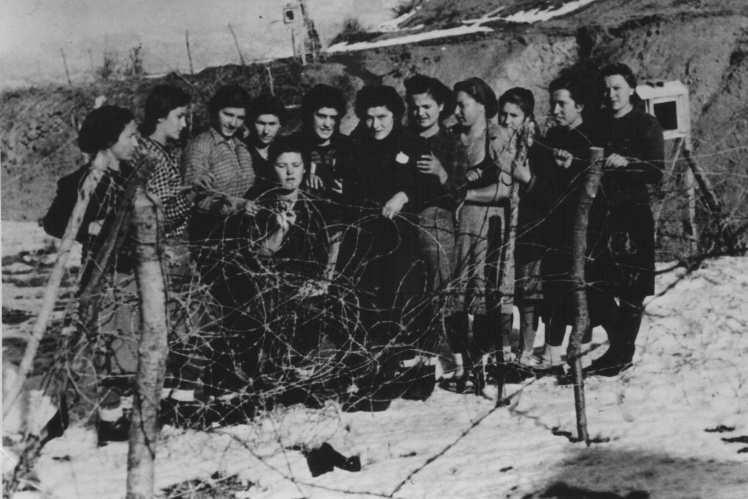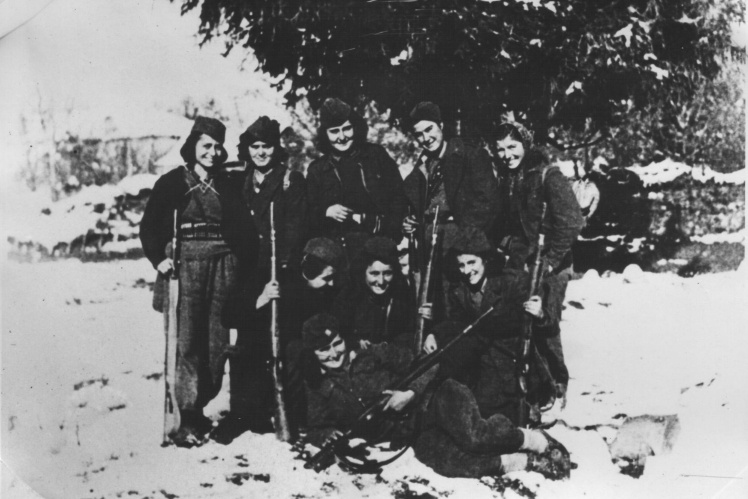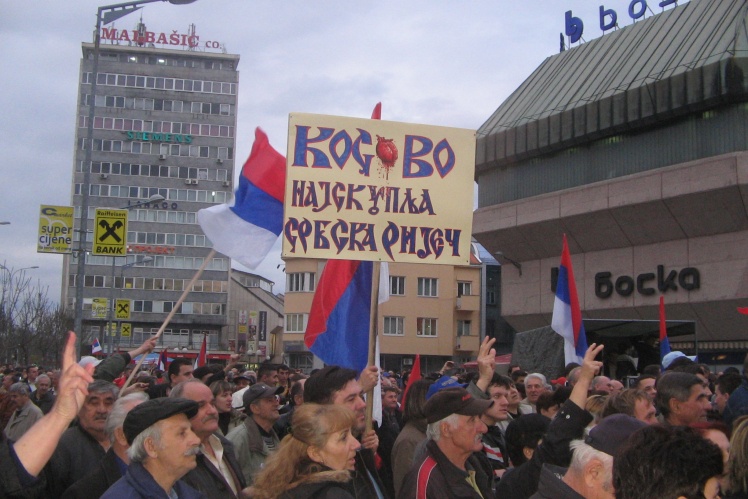History of the Serbian-Albanian conflict in Kosovo
Until the middle of the XV century, when Serbia was finally conquered by the Ottoman Empire, Kosovo was the center of the Serbian kingdom. Albanians began to populate the territory of Kosovo en masse from the end of the XVII century. At that time, these lands were devastated by the wars that the Serbs, with the support of Austria, waged against the Ottoman Empire. After several defeats, the Serbs had to flee beyond the Danube to the territory controlled by Austria.
The number of Albanians in Kosovo gradually increased. By the middle of the XIX century, it had already exceeded 50 percent. And by the end of the century, the Albanian national movement for autonomy and even independence from Turkey intensified there.
Members of the Albanian Prizren League founded in Kosovo, a military-political organization aimed at protecting the national interests of Albanians, 1878.
Wikimedia / «Бабель»
But the Serbs have not forgotten about Kosovo. And when they gained independence from the Ottoman Empire in 1878, they tried to take it under their control. However, they managed to do this only after the First World War, when in 1918, the federal state of the Kingdom of Yugoslavia emerged on the Balkan Peninsula with its center in Belgrade.
In the 1930s, the Yugoslav government made every effort to evict the Albanians from Kosovo. Albanian families were even offered money to agree to emigrate to Turkey. And Serbian and Montenegrin peasants, on the contrary, were encouraged to move en masse to Kosovo.
During the Second World War, the Italian fascists created a collaborationist regime in Albania and included Kosovo in its composition, and ethnic cleansing of the Serbian population began. During this time, about 400,000 Kosovo Serbs became forced refugees.
Serbs in a concentration camp, 1943. Kosovo female partisans, 1944.
Wikimedia / «Бабель»
After the Second World War, communists led by Broz Tito came to power in Yugoslavia. They returned Kosovo under the control of Belgrade. Until the mid-1960s, the Yugoslav State Security Service tried to suppress the Albanian national movement and staged repressions in Kosovo. But there was no success. The Kosovo communists have already started advocating for the autonomy of the region. By that time, the ratio of Albanian to Serbian population in Kosovo had reached 9 to 1.
Belgrade had to make concessions. Thus, Kosovo first became a national region and then an autonomous region with more rights. The new Yugoslav Constitution of 1974 only strengthened Kosovoʼs autonomy. The local authorities could block any decision of Belgrade if they considered it disadvantageous for themselves.
Another escalation of the Serb-Albanian conflict in Kosovo began in the late 1980s when the Serb Slobodan Milošević came to power in Yugoslavia. In 1989, he abolished the regionʼs autonomy and began brutal repression against the Kosovo Albanians. In response, the Albanians started an underground partisan movement, which in 1996 merged into the Kosovo Liberation Army.
Members of the Kosovo Liberation Army, 1999.
Wikimedia / «Бабель»
The fight against the Albanians in Kosovo turned into a full-scale war with Miloševićʼs Yugoslav army in 1998. However, by this time, a series of armed conflicts had already taken place between the Serbs, who tried to preserve the Yugoslavia state, and the peoples who sought independence from it — Croats, Bosniaks, Slovenes, Macedonians, and Albanians. The Yugoslav wars of the 1990s became one of the largest armed conflicts of the XX century, with significant destruction, many deaths, and a large number of war crimes.
It got to the point that NATO intervened in the conflict. In 1999, a military contingent of the Alliance was introduced to Kosovo, and the management of the region passed to the international administration under the UN overview.
American soldiers as part of the NATO military contingent in Kosovo, 2001.
Wikimedia / «Бабель»
Tribunal for war crimes in Kosovo
The prosecutor at the International Criminal Tribunal for Yugoslavia, Carla del Ponte, said in 1999 that about a million ethnic Albanians had been forced to leave Kosovo because of the war. She also reported on more than 11,000 dead Albanians. In 2010, three thousand people were still missing, including 2,500 Albanians, 400 Serbs, and 100 Roma.
In 1993, when the conflict between the countries of the former Yugoslavia had just begun, the UN Security Council created the International Tribunal for Yugoslavia. War crimes of all war participants were examined there: representatives of Serbia, Bosnia and Herzegovina, and Croatia. After 1998, war crimes committed in Kosovo began to be investigated.
The president of the former Yugoslavia, Slobodan Milošević, the second president of Serbia, Milan Milutinović, ex-Prime Minister of Serbia Nikola Šainović, ex-Minister of Defense and Chief of the General Staff Dragoljub Ojdanić, then Minister of Internal Affairs Vlajko Stojiljković were on trial for war crimes and crimes against humanity. The prosecution claimed that they wanted to ensure Serbian control over Kosovo. For this purpose, a number of operations were organized in which the Serbian military systematically forcibly expelled the Kosovo Albanians from their homes. To facilitate this task, the defendants created an atmosphere of fear and violence that pushed people to flee. They threatened to kill and killed the locals, robbed, destroyed their houses, farms, etc.
Kosovo refugee camp, 1999.
Wikimedia / «Бабель»
During the tribunal, several generals were also put on trial for these crimes. Some of them served prison sentences, some were acquitted.
However, not only Serbs committed international crimes in Kosovo. Several officers of the Kosovo Liberation Army also appeared before the Tribunal. They were accused of persecuting people on political, racial, and religious grounds, of murder and rape, of keeping them in inhumane conditions in concentration camps, in particular in Lapušnik. Three of the eight officers of the Kosovo Army were found guilty, which angered the Serbs.
In 2008, the prosecutor of the International Tribunal, Carla del Ponte, published a book in which she talked about the crimes of the officers of the Kosovo Liberation Army. In 2010, a member of the Parliamentary Assembly of the Council of Europe, Dick Marty, published a report accusing Kosovo Liberation Army officers, including then-President Hashim Thaçi, of crimes against Serbs and those who supported them in 1998-1999 during the Kosovo conflict. In particular, it was about the inhumane treatment of people, and the killing of prisoners for the purpose of exporting and selling human organs, which is prohibited by law.
President of Kosovo Hashim Thaçi, 2017.
Wikimedia / «Бабель»
The International Tribunal for the former Yugoslavia did not accept new cases at that time. In addition, there were opinions that the witnesses in the cases against the Kosovars could be pressured.
In order to ensure an independent investigation of the crimes of the officers of the Kosovo Liberation Army, was decided to create a separate tribunal. Under pressure from the United States and the European Union, Kosovo agreed to amend its constitution. In 2015 it, together with the EU, created the Special Trial Chambers and the Special Prosecutorʼs Office for Kosovo. It is an independent court governed by the laws of Kosovo but located in The Hague. Only foreign judges work in it. Among the high-ranking officials who ended up on the dock, there were the ex-president of Kosovo Hashim Thaçi, the former speaker of the parliament Kadri Veseli, the acting president of Kosovo Jakup Krasniqi. Currently, the Chambers are investigating the cases of eight Kosovars.
How Kosovo gained independence
Regarding Kosovo, the world community initially planned the following scenario: first to reconcile political opponents and ethnic groups and then to determine the status of the region. But such a policy did not justify itself, local conflicts and skirmishes between Kosovo Serbs and Albanians continued.
Finally, in 2006, the International Contact Group on Kosovo began negotiations on the status of the territory. All participants agreed that the problem of Kosovo is unique, and the only adequate solution is to recognize the independence of the region. But at the same time, they emphasized that this should not become a precedent for other countries.
US Secretary of State Madeleine Albright with Kosovo refugees, 2008.
Wikimedia / «Бабель»
Serbia, of course, protested and tried to maintain at least formal control over Kosovo, citing Yugoslav statutes. However, by that time, there was nothing left of Yugoslavia. In May 2006, its last republic, Montenegro, seceded from Serbia and declared independence.
In February 2008, the parliament of Kosovo unilaterally declared the independence of the region. And in July 2010, the UN International Court of Justice in The Hague confirmed the legality of this decision. Kosovoʼs independence has been recognized by more than a hundred countries, including the USA, Germany, France, and Great Britain. However, there are countries such as Spain, Greece, Cyprus, Georgia, Moldova, and Russia that do not recognize the independence of Kosovo. Ukraine takes a wait-and-see position and legally does not make a decision regarding the recognition of Kosovo.
Celebrating Kosovoʼs independence by refugees in Vienna, February 17, 2008 Kosovo Serbs protest against the declaration of independence of Kosovo, March 27, 2008.
Wikimedia / «Бабель»
As for Serbia, of course, it does not recognize the independence of Kosovo. According to the Constitution of Serbia, Kosovo is still considered a part of it, although, in fact, this region is not subject to Belgrade. Since then, the relations between Serbia and Kosovo have warmed up and become tense again.
Kosovoʼs independence has nothing to do with "LPR" and "DPR"
At the end of April 2022, during a meeting with UN Secretary-General Antonio Guterres, Putin stated that the Kremlin recognized the independence of the pseudo-republics of the “LPR” and “DPR” based on the "Kosovo precedent". And even the Serbian leadership did not like it. In particular, Serbian President Aleksandar Vučić said that such comparisons complicate the situation in the Balkans and that Putin is using Kosovo in his own interests with such statements.
Aleksandar Vučić (right) and Putin in Belgrade, 2019.
Wikimedia / «Бабель»
That is why such comparisons by the Kremlin are completely groundless:
- the basis of the conflict in Kosovo is the centuries-old Serbian-Albanian confrontation, which was accompanied by ethnic cleansing and mass murders on both sides;
- determination of the status of Kosovo took place under the auspices of international institutions, such as the UN Security Council, the Contact Group, the special representative of the UN Secretary-General, the International Court of Justice in The Hague;
- The international contact group on Kosovo, which, by the way, also included Russia, agreed that the Kosovo issue is unique and cannot be used as a precedent for other countries;
- after all, Russia itself never recognized the independence of Kosovo, as it supports Serbia in this conflict.
What is happening now
In northern Kosovo, there are several Serbian enclaves inhabited by ethnic Serbs who do not support Kosovoʼs independence. They still use Serbian currency there, use the Serbian language, and have Serbian citizenship and Serbian license plates on their cars. Despite the fact that Kosovo declared its independence back in 2008, in 2015, it was agreed with Serbia that for five years, the inhabitants of these enclaves can use their license plates but stick the markings of Serbia in Kosovo and Kosovo in Serbia. They also mutually recognized driverʼs licenses.
Kosovo Serb protests in Zvechan, 2011.
Wikimedia / «Бабель»
A week ago, the Kosovo authorities announced that starting August 1, they would stop allowing people with Serbian documents to enter their territory. The Kosovo authorities called the move "mutual", as Serbia has not recognized its documents for more than 11 years. Russia declared its full support for Serbia.
Map of the territories of Kosovo and Serbia. Mitrovica is one of the Serbian enclaves in the north of Kosovo.
And on July 30 and 31, Serbs living in the north of Kosovo started protests — they erected barricades at the entrances to and exits from their enclaves and blocked any movement. Danger sirens went on in Kosovan Mitrovica. Serbian President Aleksandar Vučić first said that in that way, Kosovo was preparing an attack but then called on everyone to calm down in order to preserve the peace. On the evening of August 31, the Kosovo government agreed to postpone the decision for 30 days on the condition that the Serbs remove all barricades and restore full freedom of movement.
Translated from Ukrainian by Olya Panchenko.
We tell the truth about historical events and debunk Kremlin fakes. Support Babel so that we can do this in the future: Patreon 🔸 [email protected]🔸donate in cryptocurrency🔸in hryvnia.





